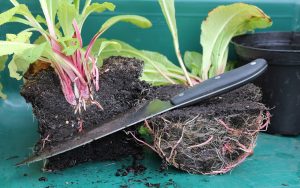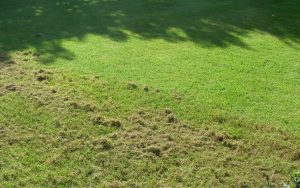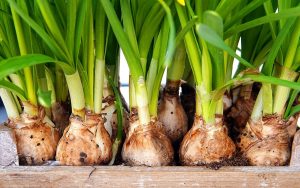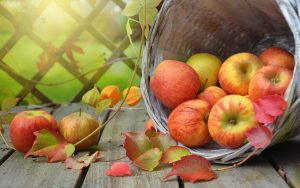Menu

As plants start to become dormant, now is a great time to divide larger ones that have formed clumps. This not only creates more plants (to move around the garden or share with friends) but also rejuvenates the original plant. Ideal candidates for division are established rhubarb crowns, herbaceous perennials (like Penstemon, Delphinium and Japanese Anemone) and hardy herbs that have grown too big for their spot (lemon balm, marjoram or chives, for example).
Dividing plants feels brutal but is actually quite straightforward. Dig up the original plant and place it on a hard surface. If the plant has tuberous or densely packed roots, using a sharp spade, slide straight down between the natural clumps of leaves. If the roots are looser, you may be able to tease off clumps of new plants using two garden forks, back to back. You can then plant one back into the original hole and then pot up your new plants for moving or sharing. Don’t forget to water them all well in!

October is probably the latest in the year you would want to lay new turf or sow grass seed. Although commercial developments will do this all year round, the cold weather definitely reduces the chances of success.
Now is also a good time to treat lawns that have become a bit compacted through use; if you have a puddle regularly forming on your lawn in the same spot, for example, this can be a sign that the soil has become compacted. Although hollow-tine forks are available, you can also aerate and decompact effectively with a regular garden fork. Firm the fork in as deep as it will go, give it a little wiggle, then remove it, leaving little holes. If you want to, you can then brush a little grit or sharp sand into the holes to help improve drainage. Like all plants, grass needs some oxygen to its roots so aerating and decompacting in this way will give it a boost.

Looking ahead to spring crops, now is the time to plant out spring cabbages, garlic cloves and any onion and shallot varieties that benefit from over-wintering. Planting small batches of hardy broad beans and peas every few weeks will help ensure a succession of crops early next year, too. Choose a sunny, well-drained spot if you can. Quick growing microgreens, like kale and mustard, will also respond quickly if you want a crop sooner than next spring. And, if you’re not planting anything in your vegetable plot over the winter, why not think about sowing a green manure, like winter rye, to enrich the soil, rather than leaving it bare.
For some autumn and winter colour, plants such as heathers, Cyclamen and winter pansies, perhaps set off with a dwarf conifer, are still looking great in beds and pots now.

If you’re not already picking them, now is the time to gather in apples, pears, grapes and nuts. Some varieties of apple and pear will store well (in a cool, dark place an
d not touching each other) but any prone to more pulpy flesh will need using quickly (or freezing, or turning into chutneys and preserves!).
If you are lucky enough to have a fig tree, remove any large fruits that haven’t ripened by now but leave any tiny fruit, as they should develop in time for next year’s harvest.
Pick any remaining runner or French beans before the frost and bad weather blemishes them. You could try leaving a few pods to fully ripen on the plant, so you can sow from your own seeds next year.
Pumpkins and autumn squash might not quite be ready to pick yet so it’s worth raising them off the ground if you can, to lift them above their leaves and expose them to any ripening sunshine.
 The long-range forecast suggests we are due a wetter, windier but milder October this year than some, so we might not have to worry about frost protection just yet. However, that’s not to say that winds and heavy rain can’t also damage your favourite plants so it’s time to start thinking about bringing anything delicate indoors, or at least to a protected spot.
The long-range forecast suggests we are due a wetter, windier but milder October this year than some, so we might not have to worry about frost protection just yet. However, that’s not to say that winds and heavy rain can’t also damage your favourite plants so it’s time to start thinking about bringing anything delicate indoors, or at least to a protected spot.
Potted citrus plants and fuchsias are best moved inside to a dry but cool (frost-free) place. This also applies to anything tropical or tender, such as bananas, Eucomis (pineapple lily), Gazanias and Coleus. Anything you can’t move (like tree ferns) should be wrapped in fleece to protect from frost.
Along the south coast, many of us find Dahlias will over-winter in the ground but, if you don’t want to risk it, lift Dahlia and Canna tubers now, dry them well and store in a cool, dark place.
If you have any hardy specimens that you know will winter in pots outside, now is the time to remove any pot saucers and raise the pots a little to prevent waterlogging (and the potential damage of that water freezing).
Further reading for October evenings:
What to plant in October – roses!
A mild autumn can be a good time to repair a lawn
Get ahead on your seed sowing for next year with our seed sowing calendars
Give your houseplants an autumn boost
Hambrooks garden design, landscaping & garden maintenance throughout Hampshire for over 50 years.

